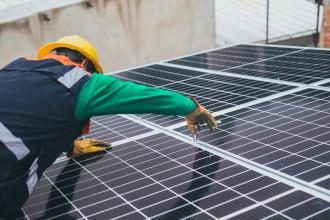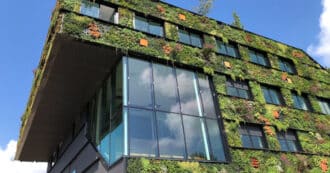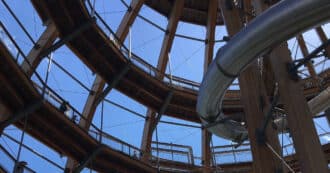By Sydney Cohen – Sustainable building materials are in high demand these days. Companies are looking for ways to reduce their carbon footprint in order to be more environmentally friendly. There is an increased interest among homeowners and builders for sustainable development, which means that green building materials will continue to grow in popularity.
So what exactly does ‘sustainable’ mean? It’s not just about using recycled or renewable resources as it also includes energy efficiency, water conservation, natural lighting and ventilation, non-toxic chemicals, and healthy indoor air quality. Eco-friendly products can help you achieve your goals of reducing the use of fossil fuels, and in turn carbon emissions, by consuming less electricity at home or at work!
Building Affects Climate Change
The construction industry is one of the largest contributors to greenhouse gas emissions. This can be attributed to the construction industry’s reliance on materials that are not environmentally friendly, such as plastics and metals.
Construction processes require large amounts of energy, which also contribute to carbon dioxide emissions and in turn to climate change. With construction being so detrimental to the environment, it’s important that we adopt sustainable building practices in order to minimize their impact on our planet.
Sustainable Building Processes
Emerging building techniques, such as passive design, allow for more environmentally friendly heating and cooling. In fact, there are many ways that sustainable architecture can have a positive environmental impact, such as “strategies that take advantage of circular economics, such as composting, efficient heating and cooling systems and LEED incentives (Leadership for Environmental and Energy Design- a rubric used for sustainable design features) which can all influence and improve the sustainability of your structures.”
Access to Sustainable Building Materials
Access to sustainable building materials is an important factor in the construction of any building. These types of materials are necessary for many reasons, not least of which is that they can be used over and over again without losing their integrity.
Sustainable materials also help promote sustainability by eliminating waste products or reducing them as much as possible.
Challenges in Australian Access to Green Building Materials
However, access to these green building materials isn’t always easy. Depending on the location needing the materials, such as Australia, for example, access to sustainable resources that contribute to sustainable design is difficult and expensive. An article on sustainable design, construction, and materials states that “for things like wood fiber and hemp insulation…getting materials sent over from Europe can take four to five months, and be four to five times as expensive as conventional materials”.
The article also explains how due to climate change, alternative sustainable design, planning, and architecture are needed in regions where the heat is increasing. However, through using recycled materials, renewable energy production, and sustainable design techniques in walls, flooring, panels, and windows, we can reduce our energy used and have a more positive environmental impact to reduce the fast-growing effects of climate change.
Eco-Friendly Building Materials
The word “eco-friendly” is used to describe something that can be maintained at a certain level. One of the ways we maintain our environment and ourselves is by using green building materials. Sustainable materials are typically made out of eco-friendly building materials such as bamboo, cork, and recycled paper products.
These materials reduce waste and help us focus on sustainability for future generations while reducing our environmental footprint now!
Green Building Materials
As the world’s population continues to grow, so does our need for energy and housing. This has led to a rise in people living in urban areas with limited space. With this increase comes the demand for green building materials that are affordable and can be used without sacrificing quality or durability.
There is no one solution to this problem, but there are many products on the market now that offer an environmentally friendly alternative to traditional building materials like wood, steel, brick and concrete. One such product is hempcrete; it is made of lime mixed with hemp shives (dried plant stems) which produces a material similar in strength to concrete while having insulation properties comparable to fiberglass insulation boards.
Sustainable Building Materials
There are many options for sustainable building materials that replace less sustainable ones. These options include:
- Bamboo
- Precast concrete slabs
- Cork
- Straw bales
- Recycled plastic
- Reclaimed wood
- Reclaimed or recycled steel
- Plant-based polyurethane rigid foam
- Sheep’s wool
- Rammed earth
- Hempcrete
- Mycelium
- Ferrock
- Timbercrete
- Terrazzo
The Advantages of These Sustainable Materials
Some of these materials have incredibly interesting manufacturing processes and uses. For example, “the sustainability of precast concrete slabs is higher than many traditional concrete options as the slabs often take much less energy to produce and assemble”.
Additionally, cork “excellently absorbs noise, making it perfect for insulation sheets, and due to its excellent shock absorption qualities, it is perfect for sub-flooring. It can also be a good thermal insulator as it is fire resistant, especially if untreated, and does not release toxic gases when it burns”.
Hempcrete “is a concrete-like material created from the woody inner fibers of the hemp plant. The fibers are bound with lime to create concrete-like shapes that are strong and light. Hemp concrete blocks are lightweight, dramatically reducing the energy used to transport the blocks. Hempcrete is sturdy, has good thermal and acoustic insulation qualities and is fire resistant. Additionally, its biggest sustainable property is that it is CO2 negative, meaning it absorbs more CO2 than it emits. Hemp itself is a fast-growing and renewable resource.”
All of these materials are much more economical and environmentally friendly than traditional materials like concrete and cement, whose production processes emit immense amounts of carbon dioxide into the earth’s atmosphere, contributing to global climate change.
The Importance of Sustainable Building and Construction
The importance of sustainable building and construction is an ever-growing topic in the industry. With the rise of global warming, it’s important to make sure that we are doing our part to contribute towards a better environment for future generations. The importance of sustainable building materials is essential because these are what will be used in today’s buildings for years to come.
The Benefits of Using Sustainable Building Materials
To start, the literal definition of “sustainable” is to create something that is long-lasting. Constructing a home that is long-lasting is very cost-efficient long-term, as it lowers maintenance costs and reduces the need for upkeep. A few examples of housing fixtures that use sustainable building materials include “low-flow plumbing fixtures, durable bamboo and cork flooring, solar panels, natural fiber wool carpeting, concrete flooring & walls, reclaimed wood, and metal roofing & siding”.
Another reason to build sustainably is by utilizing advanced framing techniques. This technique uses less wood in the framing of a house. “Advanced framing actually results in less material and labor costs, it improves the homes energy performance, it still meets building codes, and it results in a more durable, sturdy home”.
A third reason for the importance of sustainable building materials is due to energy conservation and saving of money that sustainable building materials allow. According to MyMove.com, with sustainable building materials, “energy is conserved two-fold—one, you conserve energy on a larger scale by using sustainable materials whose manufacturing results in less waste products that fill the world’s landfills. Two, you conserve your homes energy by using materials that are more efficient, such as low-flow toilets, green insulating materials that result in a better insulated home, eco-friendly heating systems, on-demand water heaters, and programmable thermostats…” which “means that you save money AND help to save the worlds resources!”.
There are many other reasons to use sustainable building materials in the construction of your home, including health benefits, waste minimization, environmental benefits, improved resale value, and more flexible styling, and you can read more about the further benefits here.
Religion and Sustainable Building Materials
“The sukkah” is a wonderful example of a structure made with sustainable building materials. The sukkah is a temporary booth made from natural materials like unprocessed wood and palm fronds that is lived in during the Jewish holiday of Sukkot.
The Sukkah can easily be built from recycled materials, and according to Eco Bible Volume 2 it “can remind us about reducing the ecological impact of a home. This accords with contemporary research which suggests that building homes with timber harvested in a renewable manner reduces the ecological impact by around 25 percent to that of cement and steel structures, without significantly affecting safety, cost, insulation, or comfort” according to Shankar Adhikari & Barbara Ozarska in “Environmental Systems Research.” Creating religious buildings that model sustainable building is a great way to practically apply our spiritual teachings.
Implementing sustainable building materials in new construction has so many benefits for human health, the economy, and the health of our planet. Let’s work together on designing eco-friendly structures with reduced environmental impact!
* Featured image source








